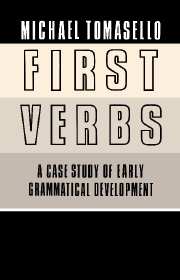Book contents
- Frontmatter
- Contents
- Acknowledgments
- Dedication
- 1 Introduction
- 2 In the beginning was the verb
- 3 Methods and an introduction to T's language
- 4 Change of state verbs and sentences
- 5 Activity verbs and sentences
- 6 Other grammatical structures
- 7 The development of T's verb lexicon
- 8 The development of T's grammar
- 9 Language acquisition as cultural learning
- References
- Appendix
- Index
9 - Language acquisition as cultural learning
Published online by Cambridge University Press: 18 December 2009
- Frontmatter
- Contents
- Acknowledgments
- Dedication
- 1 Introduction
- 2 In the beginning was the verb
- 3 Methods and an introduction to T's language
- 4 Change of state verbs and sentences
- 5 Activity verbs and sentences
- 6 Other grammatical structures
- 7 The development of T's verb lexicon
- 8 The development of T's grammar
- 9 Language acquisition as cultural learning
- References
- Appendix
- Index
Summary
Obviously one must be humble in drawing definitive conclusions from a naturalistic investigation of one child learning one language. It is important to point out, however, that many phenomena of language acquisition can only be studied with diary data, that is, data in which all of one child's linguistic productions are systematically documented in a longitudinal fashion (Mervis, et al., in press). The current analysis of T's sentence-construction operations, for example, was only possible because there was available a fairly complete developmental record. In any case, the current study has discovered some interesting facts about this one child's language acquisition that may serve as hypotheses to test with other children learning English and, with proper modification, with children learning other languages. Such generalizations are especially promising in the case of verb-related phenomena, given Maratsos's (1987) finding that the only grammatical structures common to all of the world's languages are basic predicate-argument structures.
What I do in this final chapter is three things, each very briefly: First, I summarize the major findings of the study; second, I offer a speculation on the human capacity for language (including a comparison of children and language learning chimpanzees); and third, I look briefly at later language development to see if the current approach may be extended usefully beyond the child's second birthday.
Summary of major findings
Anyone looking closely at T's early language must, it seems to me, come away with a strong impression of concreteness, particularity, and idiosyncrasy. Many linguists see these features in adult language as well (e.g., Bolinger, 1977; Fillmore, in press; Langacker, 1987), but in the case of the 1- to 2-year-old child they are even more pronounced.
- Type
- Chapter
- Information
- First VerbsA Case Study of Early Grammatical Development, pp. 264 - 274Publisher: Cambridge University PressPrint publication year: 1992



